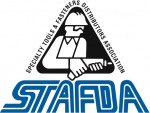STAFDA News, April/May 2013
STAFDA liaison committees offer industry insight
Each year during World of Concrete, members of the Board of the Specialty Tools & Fasteners Distributors Association (STAFDA) meet with the Association’s Manufacturer & Rep Liaison Committees to discuss business conditions, STAFDA plans and trends in the light construction and industrial markets. Below are synopses of some of their reports. Complete versions are at www.stafda.org under the “About” tab. Click on Liaison Committee.
Steve Betzler, Empire Level Mfg. Corp.:
It’s said a rising tide raises all boats. A positive trend in our industry is that demand for power and hand tools in the U.S. is projected to rise on average 4.8 percent each year over the next four years, topping out at $13.1 billion by 2016.
During the economic downturn, a number of established contractors left the business. As the recovery continues, a younger and more heavily Hispanic construction workforce is replacing them. Some unique and strong trends accompany this changing workforce. Our data suggests that 86 percent identify the U.S. as the best source of quality hand tools; 36 percent expect to, and will, pay a slight premium for Made in USA products; and 63 percent trust known/national brands in hand tools.
Jared Carter, Wolf Peak International:
The safety industry has seen some major transitions, not just in distribution channels, but also in end-users. Five years ago, many industrial and construction distributors had little interest in selling safety products. Safety was deemed too time-consuming for the dollars sold. Distributors would take an order for safety products but did very little to sell them. Not anymore. Many distributors now realize safety items are a great addition to their line cards.
They also discovered safety items are a mandatory consumable purchase. Every employee on a job site or production line must be provided with proper Personal Protective Equipment (PPE). This is required and enforced by OSHA. These products are also consumable items reordered on a constant basis. With the economy still struggling, many distributors have put a focus on pushing safety products to their customers and this has proven to be a key component in their survival.
Rocky Eggeman, Saint-Gobain Abrasives/Norton:
Now that the election is over and Round 1 of the fiscal cliff is behind us, where is the market going? Restraints on growth are unemployment and repositioning of manufacturing businesses. The U.S. is recovering while Europe is still uncertain and growth in China is slowing.
In the U.S., market indicators are predicting moderate to steady growth, with the Dodge Report predicting a six percent increase in overall construction. Key distributors throughout the U.S. are seeing the same for 2013 and expecting larger growth in 2014 and 2015.
Tim Lickel, Wacker Neuson:
By far, the biggest story in the U.S. market in 2012 was United Rental’s (URI) acquisition of RSC. United Rental is now the largest equipment rental company in the world with a store network nearly three times the size of any other provider with locations in 48 states and 10 Canadian provinces. Before the merger, URI was #1 and RSC was #2 on Rental Equipment Register’s (RER) Top 100. A STAFDA distributor might wonder, “How will this affect me since I sell supplies and equipment?”
Tom Northcott, Positec USA:
Led by new products and increased marketing, we expect 2013 to be a strong year in unit sales. The cost of manufacturing continues to rise. Although there are no major fluctuations expected with Chinese exchange rates, Chinese labor and fuel costs. Import taxes are expected to increase in the foreseeable future. Because of this,
sub-assembly and outsourcing on large, bulkier products will begin to shift back to Mexico, or the U.S. as manufacturers attempt to maintain or improve costs.
Cost reductions are essential as more margin is squeezed out of the market, mostly due to the Internet. An E-tailer’s cost of doing business is a warehouse, computer and
a picker, making it next to impossible for traditional retailers to compete on price. MAP programs can help, but are extremely hard to regulate online. Even home centers have struggled to compete.
Sebastian Rissmann, BeA Fasteners USA:
Distributors are reporting higher sales and some local and regional markets are seeing positive housing starts. On the industrial side, projections have been more solid and predictable. One of the key topics for the staple and nail industry last year was the now-averted strike of East Coast longshoremen. The issue was a container royalty dating back to the 1960s.
Today’s shipping container modernized ports and replaced blue-collar jobs with more technically savvy workers. This led to “container royalties” that guaranteed workers compensation for the weight loaded/unloaded, thus compensating for man hours lost to automation. Today this amounts to approximately $10 per hour per longshoreman, on top of their salary.
For more information on STAFDA programs and membership, please contact Catherine Usher, Member Services Director, cusher@stafda.org or 800-352-2981
or 262-784-4774. On the web, visit www.stafda.org

















